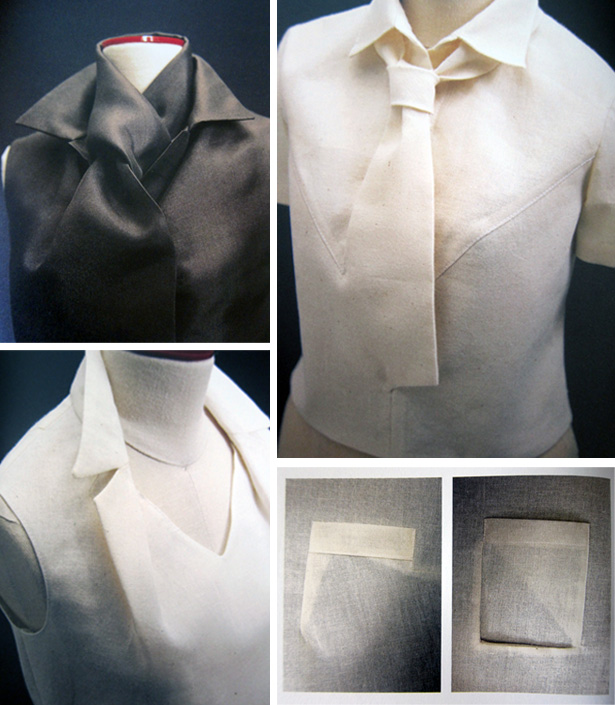One Pattern Magic book is not enough, readers, right? We just have to take a peek at the Pattern Magic 2. And yes, Laurence King Publishing is again giving away one copy to a lucky reader of this blog. But let me show you what's at stake.
The book starts with an intriguing design where a three-dimensional shaping is achieved using design lines instead of traditional bust, shoulder and waist darts. Relatively simple once you know how it works.
Before, I was often intrigued about the process of incorporating design lines - those seams and details that usually don't serve as shaping. Nakamichi's method is mostly free of trial and error - with some fabric manipulation you may just draw a shape on your three-dimensional sloper, cut along the new lines and get a pattern. It is the best method I know, in my opinion, but still it is not that simple. It would only make sense to try the project illustrated by Nakamichi before attempting own design, as you won't come around making some slits and folds in places where the pattern won't lie flat - this does require some guidance, at least for the first time.
Geometry is the main topic of this book section as Nakamachi integrates different shapes into her designs.
Fun, fun, fun part for anyone who loves intriguing garment details: a vanishing scarf, a vanishing tie, a vanishing lapel, and three variations of a vanishing pocket.
So, are you ready for the giveaway, readers? If yes, leave a comment by Wednesday, December 5, The winning comment (chosen by random drawing) will get Pattern Magic 2 in English.
One small detail! In your comment, please share with the rest of us which style, from those featured in this review, you like the most.
Good Luck!
The book starts with an intriguing design where a three-dimensional shaping is achieved using design lines instead of traditional bust, shoulder and waist darts. Relatively simple once you know how it works.
Before, I was often intrigued about the process of incorporating design lines - those seams and details that usually don't serve as shaping. Nakamichi's method is mostly free of trial and error - with some fabric manipulation you may just draw a shape on your three-dimensional sloper, cut along the new lines and get a pattern. It is the best method I know, in my opinion, but still it is not that simple. It would only make sense to try the project illustrated by Nakamichi before attempting own design, as you won't come around making some slits and folds in places where the pattern won't lie flat - this does require some guidance, at least for the first time.
"Always be flexible in your thinking as you find ways to complete your garment," - a reasonable advice from Nakamichi since many of her designs are very much a launching pad for your creativity.
PART 1: PLAYING WITH GEOMETRICS
Geometry is the main topic of this book section as Nakamachi integrates different shapes into her designs.
"...When you wrap these shapes around you, the excess fabric flares or drapes elegantly. I also tried incorporating artistic forms and details. Geometric figures can produce beautiful shapes."Yes, some of these garments are truly artistic and, for me, less wearable, but I love peeking at the engineering process so well illustrated in Nakamichi's books. It's like being in a museum archive and being able to touch and examine the pieces.Yet there are also styles that can make a great addition to your wardrobe. Here, my favorites:
 |
| (From top left) Just like a stole, A ball-shaped accordion (jabara), Wearing a square, Square accordion (jabara) |
PART 2: DECORATIVE STRUCTURES
"Twisting, catching, draping - various methods with which to capture different qualities of fabric and incorporate them into elegant garments"I love this part which is full of beautiful and intricate styles and my absolute favorite that I plan to try for a summer style is the Flip turn, and its variation Flip turn for a draped effect.
"I increased the depth of the shadows by rotating the fabric and then flipping it over like the flip turn of swimmers in a pool."- no worries, readers, if this rather poetic explanation don't help a lot, diagrams in the book are more illustrative.Another great pattern manipulation technique to learn is Different facings, different looks. It is amazing to see how differently shaped facing change the look of an almost identical bodice.
PART 3: IT VANISHED
Fun, fun, fun part for anyone who loves intriguing garment details: a vanishing scarf, a vanishing tie, a vanishing lapel, and three variations of a vanishing pocket.
THE BUNKA-STYLE SLOPER FOR AN ADULT WOMAN
One problem a novice to patternmaking may encounter is the bodice sloper in the book.
"The Bunka-style sloper (block) for an adult woman," says Nakamichi, is "created for the body shape of the modern Japanese women."
What that means to someone who has a similar shape like me - a relatively curvy, pear-shaped body - is that we either have to do a few fitting adjustments to the sloper, or try to manipulate an existing fitted sloper before proceeding with the projects. Overall, I don't think it is a huge issue, because it is a good habit to work with a fitted sloper anyway. So, incorporate this step in your planning if you are want to create an entire garment piece based on Nakamichi's projects.
THE GIVEAWAY
So, are you ready for the giveaway, readers? If yes, leave a comment by Wednesday, December 5, The winning comment (chosen by random drawing) will get Pattern Magic 2 in English.
One small detail! In your comment, please share with the rest of us which style, from those featured in this review, you like the most.
Good Luck!





